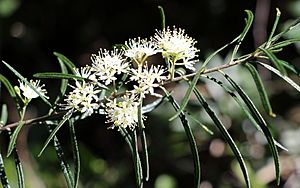Toothed phebalium facts for kids
Quick facts for kids Toothed phebalium |
|
|---|---|
 |
|
| Castlecrag, Australia | |
| Scientific classification | |
| Genus: |
Leionema
|
| Species: |
dentatum
|
| Synonyms | |
Leionema dentatum, often called the toothed phebalium, is a special type of large bush or small tree. It grows only in New South Wales, Australia. This plant has leaves that can look a bit different from one plant to another. It also has thin branches and groups of creamy-yellow flowers that bloom in spring.
Contents
What Does the Toothed Phebalium Look Like?
The Leionema dentatum is a bush or small tree that can grow up to 6 meters (about 20 feet) tall. It has thin, somewhat needle-shaped stems.
Leaves of the Plant
The leaves of this plant can vary a lot. They might be narrow and long, oval-shaped, spear-shaped, or very thin. They are usually 4 to 8 centimeters (about 1.5 to 3 inches) long and 1 to 8 millimeters (less than half an inch) wide. The leaves are smooth and have a squared or blunt tip, often with two small "teeth." Their edges can be rolled under or slightly upward, and they might have small teeth. The underside of the leaves is white with tiny star-shaped hairs and a raised line down the middle.
Flowers and Fruit
The flowers grow in clusters of about 10. Each cluster sits on a short, angled stalk called a peduncle, which is 2 to 8 millimeters long. The individual flowers are on even thinner stalks called pedicels, about 4 millimeters long.
The green outer leaves of the flower, called calyx lobes, are wide and triangular. The petals are light yellow to white, about 3.5 millimeters long, and smooth. They also have tiny dots that are actually glands. After the flowers, the plant produces fruit that stand upright on the stem. These fruits are about 3.5 millimeters long and have a small, distinct point at the end.
How the Toothed Phebalium Got Its Name
The plant Leionema dentatum was officially described in 1998 by a scientist named Paul G. Wilson. His description was published in a scientific paper called Nuytsia.
Meaning of the Name
The second part of its scientific name, dentatum, comes from a Latin word. It means "toothed," which refers to the small teeth often found on the plant's leaves.
Where the Toothed Phebalium Grows
This plant mostly grows in New South Wales, Australia. You can find it from Gibraltar Range National Park all the way down to the Illawarra region in the south. It prefers to grow on sandstone soil in dry sclerophyll forests. These are forests where the trees and shrubs have hard, tough leaves to help them survive in dry conditions.

